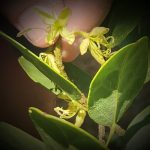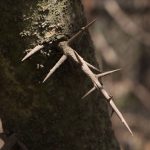
TREE LIFE 534
FEBRUARY 2025
PLANNED EVENTS: FEBRUARY
Since inclement weather or other issues may vary our plans, WhatsApp Tony Alegria on 0772 438 697 to join our WhatsApp group for last minute updates.
Saturday 1st February 2025: visit to the National Botanic Gardens. Meet at 8.30 in the main car park and join us for a morning looking at trees that catch our interest.
Main meeting 15th February 2025: Katrin and Steve Gamble’s lovely garden in Kent Road, Highlands. Meet at 2:30 p.m. Directions: Coming from town on the ED Mnangagwa (Enterprise) Road, turn right into Kent Road (shortly before the Lewisam Shops and first right after Nazareth House), No 34 is on the right before the hill.
Please check your WhatsApp for details (including “weather” the outing has been finalised due to rainy conditions!)
REPORTS FROM PREVIOUS OUTINGS
Saturday 4th January 2025: National Botanic Garden Outing
This event was cancelled as the previous night’s rain had made the paths rather muddy and slippery and it was expected that the rain would continue through the morning.
Main meeting 18th January 2024: Visit to the Borrowdale Veterinary Clinic
By Tony Alegria
It had rained during the night and if it had rained nearer the start time of 9:30 a.m., then the trees would have continued to drip for ages or if it was raining at the start time, the outing would have had to be cancelled. As it happened, the sky began to clear but after a couple of hours started to cloud up again, but thankfully, no rain whilst we were botanising. We did our best to avoid puddles and muddy patches!
So it was with fingers crossed that the following turned out – Ladies: Ann Sinclair, Dawn Siemers, Dido de Swardt, Linda Hyde, Margie Skinner, Marina Mason, Soo Fawcett and Teig Howson. Guys: Ian Riddell, Jan van Bel, Jim Dryburgh, Karl van Laeren, Mark Hyde, Tony Alegria and a non-member, Paul Grobler. Paul joined the society after the botanising ended.
Our host, Karl van Laeren, has occupied the site for some 30 years and has planted some 100 trees – not only on his property, but also along the right-hand side of the access road! Karl is well known for his love of the lowveld which was reflected in the trees he has planted. Almost without exception all are pretty big now.
The first tree we looked at was only a few years old, but already some 5 metres tall, but they can get up to 50 metres, so definitely not a tree for small gardens. The Milicia excelsa is a rather a rare tree in Zimbabwe with only a few of them in their natural habitat in Gonarezhou. Other than that, there are three in the National Botanic Gardens and a few others around. There is only one male tree in the National Botanic gardens that has had flowers. We have never seen any flowers on the other two trees so we don’t know whether they are male or female.
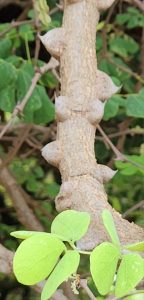
Senegalia (Acacia) nigrescens
The second tree we looked at was a big acacia whose identity needed confirming – it turned out to be an Senegalia (Acacia) goetzei subsp. goetzei. This was followed by a rather stunning example of Senegalia (Acacia) nigrescens with with 2-3 pairs of pinna on each leaf and each pinnae with only 1-2 pairs of oval to near-circular leaflets.
We then moved along to the access road to where the property extends to the road running in parallel to the Borrowdale Road.
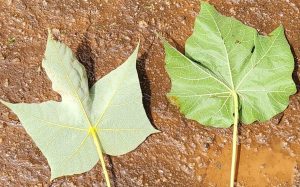 Here were two similar looking Sterculia, one on either side of the access road. The one in the property had large 5-lobed simple leaves with long petioles so was definitely a Sterculia quinqueloba – some flowers on that tree also confirmed its identity. However, Karl said the other tree was a Sterculia africana but it had no fruit or flowers. This tree had petioles of varying lengths and also some 5-lobed leaves and others which could perhaps be 3_lobed – difficult to tell!
Here were two similar looking Sterculia, one on either side of the access road. The one in the property had large 5-lobed simple leaves with long petioles so was definitely a Sterculia quinqueloba – some flowers on that tree also confirmed its identity. However, Karl said the other tree was a Sterculia africana but it had no fruit or flowers. This tree had petioles of varying lengths and also some 5-lobed leaves and others which could perhaps be 3_lobed – difficult to tell!
EDITORS NOTE:
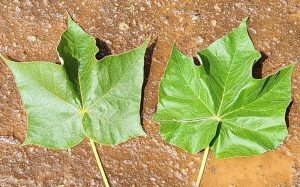
Sterculia quinqueloba (L)
and
Sterculia africana (R)
We took leaves from both to compare, and close examination showed that even when the number of lobes was ambiguous, the number of veins in the leaf was not. Of the leaves we examined we noted 2 further features: firstly, the underside of the leaf of the Sterculia africana was a different colour, being greyish, and secondly that the overlap of the leaves at the stalk was anticlockwise on the Sterculia quinqueloba leaf and clockwise of the Sterculia africana leaf.
Along this access road were two fig trees side by side so it was really easy to compare the Ficus glumosa Hairy rock fig, which can have rather hairy young leaves and petioles. The Ficus stuhlmannii Lowveld fig has woolly under-surfaced leaves with prominent net-veining. However, not always easy to tell apart!
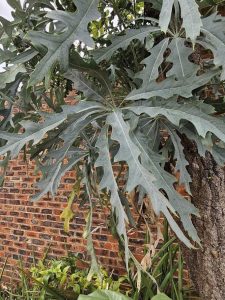
Cussonia paniculata
We also saw three species of Cussonia, namely Cussonia arborea, Cussonia spicata and Cussonia paniculata. I have never seen the Cussonia paniculata before, which comes from the former Transvaal. It would be interesting to see if there are any more growing in private gardens.
Also seen was the Pink medlar Feretia aeruginescens, a shrub from the Coffee family. This has attractive white flowers and red rather radish-like fruits borne on the old wood. Neither flowers nor fruits were present on this occasion but the species has a distinct pink main vein on the underside of the leaf.
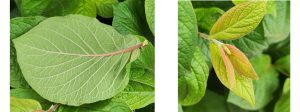
Pink medlar, Feretia aeruginescens
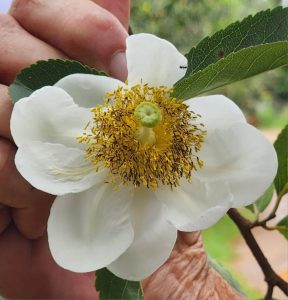
Fried-egg flower, Oncoba spinosa
In flower was the beautiful Fried-egg flower, Oncoba spinosa. It is a native tree which is commonly planted in gardens. The female stigma sits above the beautiful yellow pollen bearing anthers which attract bees and insects.
Some of the other trees we saw but not mentioned above included: Acacia nigrescens, Triplochiton zambesiacus, Adansonia digitata, Sclerocarya birrea, Bolusanthus speciosus, Bridelia micrantha, Trema orientalis, Combretum erythrophyllum, Combretum imberbe and Terminalia gazensis.
FROM THE WALRUS TO THE CARPENTER
The Walrus and the Carpenter
Were walking close at hand;
“If this were only cleared away,”
They said, “it would be grand!”
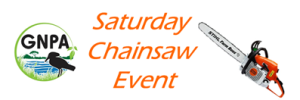
A number of volunteers gathered on Saturday 4th of January at Greystone Nature Preserve (GNP) a ‘chainsaw event’ to remove some of the larger exotic vegetation.
The GNP spans approximately 8 hectares in the suburb of Greystone Park and is part of the ecologically important wetlands.
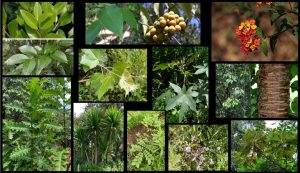
Some of the exotics at GNP
Some of the invasive species present include: Acanthus polystachius (Prickly acanthus), Acrocarpus fraxinifolius (Kenya coffee shade tree), Bocconia arborea (Tree Poppy), Cestrum aurantiacum (Orange Cestrum), Coleus barbatus, Duranta erecta (Golden Dewdrops), Fraxinus cf. americanus (American ash), Homalanthus opulifolius (Queensland poplar), Jacaranda mimosifolia (Jacaranda), Jasminum mesnyi (Japanese jasmine), Lantana camara, Ligustrum lucidum (Glossy privet), Michelia champaca (Orange magnolia), Parthenocissus quinquefolia (Virginia creeper), Populus × canescens (Grey poplar), Populus deltoides (Match poplar), Prunus cerasoides (Himalayan flowering cherry), Ricinis communis var. communis (Castor oil plant), Salix babylonica (Weeping willow), Solanum mauritianum (Bugweed), Solanum seaforthianum (Brazilian nightshade), Tecomaria capensis (Cape honeysuckle), Toona ciliata (Cedrela).
The trees do provide shade, places for birds to nest, and are part of the familiar landscape. Unfortunately, as with un-neutered cats allowed to roam and reproduce freely, leaving nature to its course (within this urban context) has shown a very strong trend towards the reserve becoming a dense jungle of exotic vegetation, which affects the natural ecosystem and biodiversity as well as the normal water table. With each year of growth, an exotic tree becomes more difficult and more expensive to remove, eventually needing professionals to get involved. Thus the question of tree removal quickly becomes more about the economics and the management capabilities than being a question purely of ecology.
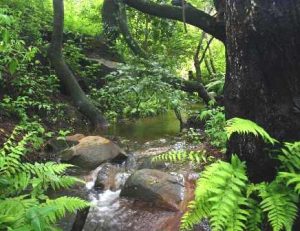
Stream below the dam –
photo: Bart Wursten Nov 2008
There have been mixed opinions from GNP neighbours about the removal of large trees there. To be clear, it is only exotic trees which are being removed, but still, very understandably a few of the residents who are fond of the park do not want to see any trees cut down.
The Chainsaw event was very successful, which, after several discussions with neighbours, led to some large Cedrela (of which 20+ had sprung up in the upper grassland), and two Eucalyptus trees being felled. We also removed about 100+ Glossy Privet trees from below the dam wall which shows how much they had spread.
Some neighbours have asked for the larger trees such as Kenya Coffee shade trees to remain. The Kenya coffee shade trees, although not as prolific in their seedling production, are difficult to control due to their fast growth, enormous size, and risk to fences and neighbours around once they die.
However there is a shortage of hands on the ground who are willing to cut and spray the numerous seedlings which spring up from the seed and roots of the exotic trees. We are therefore keen to remove the parent trees, thus reducing the number of seedlings springing up from seeds and roots each year.
Discussions also included the status of Phoenix reclinata (Wild date Palm) and Dracaena steudneri, which are technically indigenous; however, it is tempting to group them within the exotics, as they look out of place in the lower section of GNP. Please share your thoughts if you have insights into these species.
It is difficult to make pure ecological decisions when GNP is so unnatural in many ways, being situated between houses on all sides.
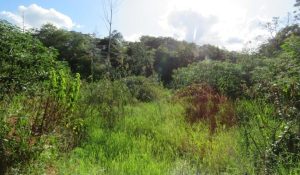
Alien invasives –
Photo: Rob Jarvis April 2022
Another point of discussion at GNP is the dam, as it is leaking badly at present. It was built prior to 1957. A collapse happened in January 2017 after heavy rainfall. After this, a MoA was signed between the Greystone Nature Preserve Association and the City of Harare to safeguard the precious wetland from all forms of human abuse, as is the case with other wetland areas. Restoration plans were provided at no charge by Engineer Ken Nicholson, and the actual reparation was undertaken by Mandebvu Contracting in 2019.
Unfortunately, the seepage continues, meaning the dam is still only seasonal. In 2024, motivated residents were spurred on by the GNP warden to send their gardeners to help to clear vegetation, in order to get to the root of the problem. It was advised that trees should never have been allowed to grow on the wall, as these are now decomposing stumps, which leave drainage channels behind. Additionally, termite mounds need to be managed. We are planning to hire earthmoving equipment to remove stumps and hollow out termite mounds, to plug those holes. We may do a fundraiser to purchase DamFix product which may also help with plugging holes.
Current work at GNP includes:
- Sending gardeners on a Wednesday morning, to cut and spray smaller exotic seedlings, trim paths, and to trim the re-growth of reeds on the dam wall.
- The occasional chainsaw day to chop the larger trees.
- Watering, mulching and clearing around tree seedlings.
- Discussions with City of Harare to try to secure the rights to fence and manage the Binton-Ettington wetlands upstream of GNP, as this is the catchment area for the dam.
- Tree planting (we plant indigenous seedlings in the lower dam area only, as it is drier and has existing miombo vegetation).
If you’d like to help with the work at GNP, these are areas where we need help:
- Ecological advice within an urban context.
- Naming help – Beth will produce metal labels but needs help with identifications.
- Donations – for felling larger trees, for fuel for trimmers and chainsaws, JCB excavator hire for removing stumps and termite mounds on the dam wall, or donations of a gardener to assist on Wednesday mornings.
- Major donations if a company or individual feels compelled to help to fix the dam wall properly.
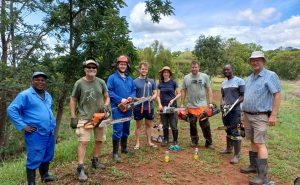
Chainsaw event volunteers, led by Mik Norton (3rd from right)
Many thanks to Neil Fairlie, warden of GNP for the overseeing of activities, committee and discussions with CoH. Many thanks also for all those who send their gardeners down, as well as those who came to help with the chainsaw event.
But wait a bit,’ the Oyster cried,
Now I’ve read this chat;
I’m very grateful for this note,
Beth Goodwin, thanks for that.
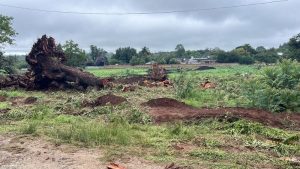
EDITORS NOTE Our congratulations go to the Harareans On Bikes, residents of Greystone Park and Ward 18, Borrowdale Residents and Ratepayers Association and all the other people who noted the above damage to the wetlands above the dam, raised the issue with the City of Harare and signed the petition to stop this sort of development on the wetlands. However, the battle is not over as they now have to fight to legitimise and authenticate this position.
The Tree Society will be organising a meeting at the GNP in March to help members and the public to identify the trees (and probably some of the herbaceous plants) growing in and around this wetland and hence contribute to plans for this critical area in the future.
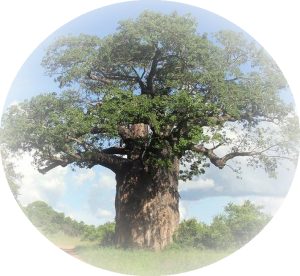
Baobab on the high veld
FURTHER ISSUES FOR THIS OYSTER
IS THIS AN INDIGENOUS PLANT?
By Linda Hyde, photos by Bart Wursten
This concept is discussed widely on the internet, including the Flora of Zimbabwe (https://www.zimbabweflora.co.zw).
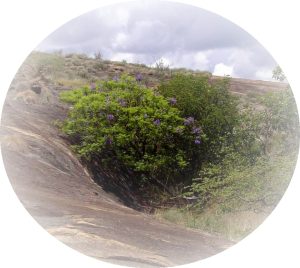
Escaped Jacaranda
It occurs to me that there are a number of words which can be used to describe the origin of a plant; indigenous, native, endemic; local; domestic, aboriginal.
Or indeed the opposite: introduced; imported; foreign; alien; invasive and exotic.
So which word should one use?
The first point to raise is that all these descriptions refer to a locality and it should be important to establish that.
For example consider the Jacaranda (Jacaranda mimosifolia) and the baobab (Adansonia digitata). Both are common in Zimbabwe, and, however the baobab calls our lowveld “home” while the Jacaranda is “at home” in Brazil. They have both adapted to life on the Zimbabwe highveld although the Jacaranda is definitely more successful.
As a basic concept:
NATIVE (PLACE YOU CALL HOME) VS INTRODUCED (NON-NATIVE)
And some basic categories might be:
NATIVE / INDIGENOUS SPECIES
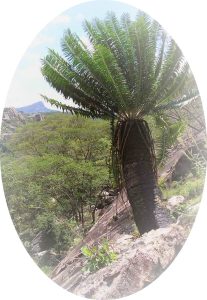
Encephalartos concinnus in Matabeleland
It appears that these terms are used interchangeably with native perhaps being slightly more restrictive referring to plants which occur in a particular area purely by reason of naturally occurring phenomena. In practice we use the term indigenous to mean native to Zimbabwe so even if you plant a baobab in your Harare garden it is called an “indigenous species” which is native to the lowveld.
ENDEMIC species are geographically isolated, being confined to a specific area and nowhere else. Endemic species only prosper under a certain set of specialized conditions found in particular habitats. Their survival and growth is limited because they can only flourish under a strict set of naturally occurring conditions and they are therefore at an elevated risk of extinction. An endemic species is, however, also native or indigenous to that area.
A classic example is the cycad which Di Drummond showed us on our recent trip to Matabeleland, Encephalartos concinnus. There are probably 3 populations all in Zimbabwe which are referred to as the Gwanda, the Mberengwa and the Runde subpopulations and this plant is endemic to those regions.
INTRODUCED OR NON-NATIVE SPECIES
Introduced species are those that occur in an area through human influence — either purposefully or accidentally.
Other terms referring to where a plant can be found are:
COSMOPOLITAN SPECIES
May be used to describe species that might be found globally in a particular type of habitat but not necessarily everywhere. In particular the polar regions, deserts, high altitudes and other extremes may be excluded.
….. And when all else fails use
CRYPTOGENIC SPECIES
While a native or introduced species is usually easy to categorize, that’s not always the case. The species may have been introduced relatively recently by ancient humans, appeared there naturally in relatively recent natural history, or have been there for eons. A cryptogenic species is one whose origins are unknown or cannot be definitively determined.
BUT WHEN IS A SPECIES INVASIVE?
An invasive species is one that is introduced into an ecosystem and thrives so well that it negatively affects native species and often reduces biodiversity in their new habitat.
A common misconception is that introduced and invasive species are interchangeable terms, but these are actually distinct. Introduced species don’t necessarily have a negative impact on their new ecosystem and could even be beneficial. However, an introduced species has the potential of becoming an invasive species.
Once an invasive species becomes established it can be difficult to remove the species and restore the ecosystem.
Further questions are:
“What if an invasive species is wreaking havoc on an ecosystem in one area, but is actually critically endangered in its native ecosystem?” OR “Can a native species be invasive?”
The issue of invasive species is never an easy or straightforward one.
I would love to have examples, thoughts and ideas from members relating to this issue.
SOCIETY COMMITTEE AND CONTACTS
Chairman Tony Alegria tonyalegria47@gmail.com 0772 438 697
Vice Chairman Mark Hyde mahyde@gmail.com 0772 233 751
Honorary Treasurer Bill Clarke wrc@mweb.co.zw 0772 252 720
Secretary Teig Howson teig.howson@gmail.com 0772 256 364
Venue Organiser Ann Sinclair jimandannsincs@zol.co.zw 0772 433 125
Committee Member Jan van Bel jan_vanbel@yahoo.com 0772 440 287
Committee Member Ryan Truscott ryan.kerr.truscott@gmail.co 0772 354 144
Committee Member Sibusiso Malunga busimalunga@yahoo.com 0775 889 898
Tree Life Editor Linda Hyde Lmharwin@pentact.co.zw 0772 232 075
Tree Society Website https://treesociety.org.zw/
Tree Society Facebook https://www.facebook.com/groups/ztreesociety/
Flora of Zimbabwe: https://www.zimbabweflora.co.zw/
Flora of Tropical Africa: https://plants.jstor.org/collection/FLOTA

